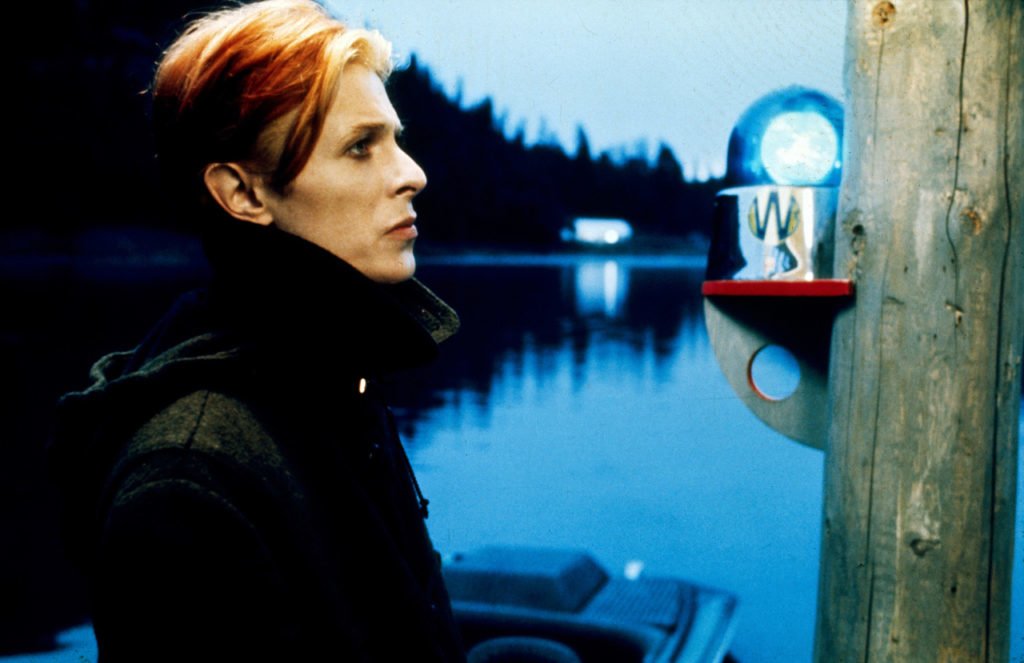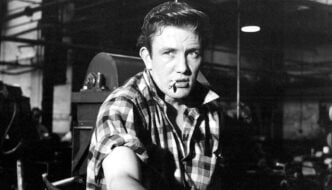
Throughout the ’70s, Nicolas Roeg was without peer, making four films which established him as one of the most startlingly original voices British cinema has ever produced. Having collaborated with Donald Cammell on what has come to be recognised as the definitive statement on the dissolution of ‘swinging London’, Performance (1970); Roeg set off for the outback of Australia to make the searing Walkabout (1971); then transmuted Venice into a Freudian labyrinth with Don’t Look Now (1973). Roeg’s final film of the decade took Walter Tevis’s 1963 novel about an extraterrestrial crash landing on Earth from a drought-stricken planet and filtered it through the fractured timeframes, oneiric visuals, thematic richness and mysticism which has enraged and enraptured critics and audiences in equal measure.
To mark its fortieth anniversary, The Man Who Fell to Earth is back in theatres with a resplendent 4K restoration which reifies the density of dream contained within every enigmatic, elliptical frame; and reminds one that Roeg is the counterculture David Lean. The Man Who Fell to Earth is an alien’s view – both Bowie’s Mr. Newton and Roeg – of post-Watergate America, a portrait of a shaken people celebrating a Bicentennial which only seems to magnify the fissures in the social fabric. But there is also a feeling of time coming loose from its moorings; a world irrevocably changed by Mr. Newton’s arrival and the many inventions which make him a Howard Hughes-esque reclusive millionaire, yet also conspicuously the same. It is this sense of temporal and philosophical dislocation which gives this, and all of Roeg’s films, the feeling of an incantation; time seems to unfold at different rates for different characters, as if parallel streams are occurring simultaneously.
A recurring theme in Roeg’s work is that of characters embarking on journeys – external and internal – from which they cannot return; exiles figure frequently in the Roeg universe, and there seemed to be no more aloof a cultural figure at that time than David Bowie. Bowie had reinvented himself again as The Thin White Duke: a stylish cipher who sang of romance with studied intensity; a mad aristocrat flirting with fascistic iconography. It is unclear where the Duke ends and Mr. Newton begins; it is hard to tell if Bowie is performing or merely being; if Mr. Newton was an extension of who Bowie was – or was pretending to be – at that time. As with the use of Mick Jagger in Performance, it was an intuitive piece of casting on Roeg’s part. Roeg hit upon the idea of using Bowie after seeing him in the BBC documentary Cracked Actor (1975), which followed Bowie on his Diamond Dogs tour; capturing a frail, wraithlike figure watching the world from the window of his limousine. Bowie’s Mr. Newton is a thoroughly reptilian presence which less commands the screen as haunts it; a study in literal and figurative alienation who imbibes the best and worst qualities of humanity.
Graeme Clifford’s editing seeks to replicate the motions of consciousness and the functions of memory, dealing in lengthy digressions and arcane connections which adhere to their own carefully constructed logic. There is the feeling of seeing the world afresh, with Anthony B. Richmond’s cinematography giving the familiar an uncanny patina, shot with a coolness which makes Mr. Newton’s appraisals manifest. The Man Who Fell to Earth is a work which further develops Roeg’s preoccupation with the mysteries of time and manifold ways of seeing, asserting that we are all strangers in a strange land, struggling to make meaningful contact. For all its ’70s benchmarks, The Man Who Fell to Earth is still a strikingly contemporary work in its depiction of Mr. Newton’s tech conglomerate eating up the competition and colonizing every facet of life with its promises of blissful inertia.
Roeg tapped into a current which offered a more disquieting variant on the Visitor of The Day the Earth Stood Still (1951); one which may have guided us towards a new solemnity and seeking, had not the Space Opera reasserted itself and a cinema of ideas was usurped by one of spectacle – by the beginning of the ’80s, Mr. Newton had transmogrified into E.T. Roeg and writer Paul Mayersberg imagine the alien as a flawed creature driven by his appetites and the blandishments of a media-saturated landscape, as fallible as the human outsiders and rebels brought together by the force of his genius. The Man Who Fell to Earth remains an engrossing puzzle whose textural and conceptual reverberations continue to be felt; it is rivalled only by A Clockwork Orange (1971), Solaris (1972) and Stalker (1979) as the apotheosis of ’70s cerebral Sci-Fi. In spite of its wilful obliqueness – perhaps because of it – The Man Who Fell to Earth has matured into Roeg’s masterpiece; the defining statement of this grand alchemist of cinematic movement, mystery and metaphor.
Follow Daniel Palmer on Twitter at @mrdmpalmer
Filed under: Film, TV & Tech
Tagged with: alien, anniversary, British, Candy Clark, David Bowie, fortieth, Nicolas Roeg, Paul Mayersberg, Rip Torn, Walter Tevis



Comments